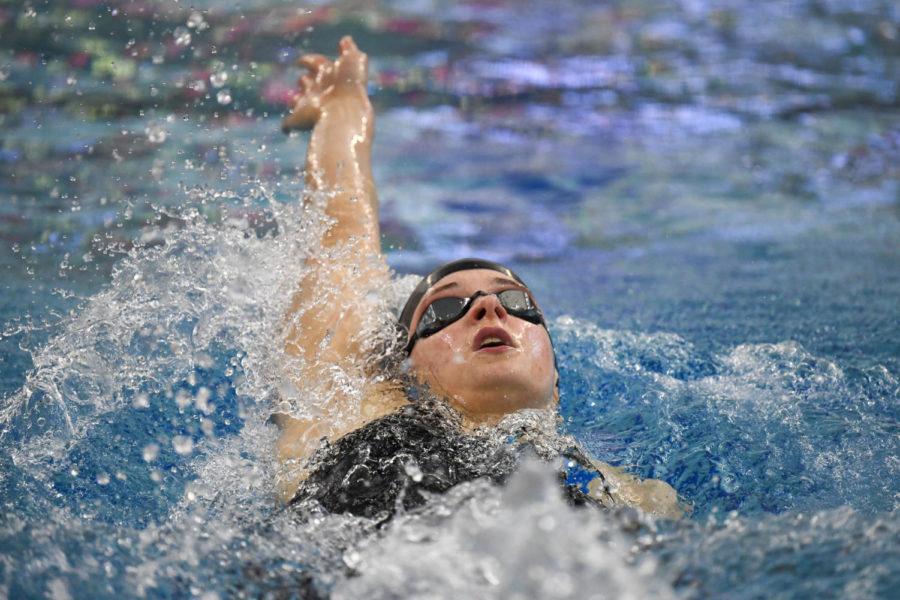Title IX: Swim and dive and the power of freedom
Dale Sparks/ALL-PRO Photography & Framing
Fallon Dewitt competes at the 2022 Big 12 Swim and Dive Championships on Feb. 24, in Morgantown, West Virginia.
July 3, 2022
Like everything in life, humans have evolved from their survival instincts to create beautiful ways to express their autonomy and skill.
In this case, swimming and diving are sports that embody freedom to the fullest with five different swim strokes and many ways to dive from different platforms.
Aquatic sports altogether provide a sense of peace by going into a space where one is alone with themselves. Away from society and the rollercoaster of life is where freedom is found.
Where everything started
Swimming originated in Britain around the 1800s, according to Britannica. Around this time, only men participated in the sport, and there were only two strokes for competitive swimming, sidestroke and breaststroke. As time progressed, freestyle was added to the sport, and swimming became more exciting.
Swimming’s first debut on the Olympic stage was in 1896, but women weren’t allowed to compete until the Olympics of 1912. The highlights of women’s swimming came shortly after they began competing, as they started to break men’s records right away.
“For example, Sybil Bauer was the first female to break the men’s 440m backstroke record,” former Iowa State swimmer Martha Haas said.
Alongside swimming, diving, previously known as “fancy diving” according to British Swimming, made its debut in athletics as a form of gymnastics early in the 19th century. In 1904, diving became an Olympic sport. On the international stage, diving and swimming gather one of the largest crowds compared to other international sports.
Women were also included in diving during the Olympic games of 1912. Since then, swimming and diving have been competing alongside each other.
All around athletics, women have been breaking records, challenging stereotypes and overcoming everything put in front of them. Women in swimming and diving changed the sports for the better.
Women in aquatic sports inspire many people by proving that goals are meant to be achieved, and records are meant to be broken, even if you’re a woman.
Fanny Durack from Australia became the first Olympic champion, and Gertrude Ederle was the first woman to swim across the English Channel. These women and many other role models within aquatic sports have paved the way for what the sport is today.
Even with all the social hurdles, Title IX continues to serve as a vessel for women to continue breaking records and expanding their talents in swimming and diving.
Title IX’s impact
Across the board, Title IX allowed women to participate in college sports and have equal access to education, gear and athletic facilities. Within the ISU swimming and diving program, Title IX emphasized traveling and culture.
The program focused its recruiting vision on international waters, granting them the opportunity to gain swimmers from New Zealand, South Africa, Israel, Canada, China and Puerto Rico.
Furthermore, the program takes its athletes to Puerto Rico every four years to participate in a swimming camp. This camp, aided by Title IX, is a great opportunity for the program to expand their swim skills and connect with different cultures.
Stepping out of the Midwest and into the Caribbean is a great way to grasp Title IX’s power. Plus, it creates motivation, drive and determination to push themselves to their full potential; traveling provides the athletes with something to look forward to.
Challenges and future improvements
Although Title IX has provided women with many opportunities, it also has its challenges and areas where it can improve.
When it comes to facilities, the ISU swimming and diving program hasn’t had an updated facility in nearly a decade; therefore, it becomes a challenge to build a bigger team or even practice certain diving skills because the space doesn’t allow for it.
Women in sports continue to face many challenges because individuals who have the power to change things settle for the bare minimum.
However, every day, strides are taken to enhance women’s paths in athletics, for example, hiring female coaches, female athletic trainers and female strengthening coaches. Women rising to authority figures is one of the many ways Title IX is applied every year.
In light of celebrating 50 years of Title IX being passed, women continue to work towards equity in the pool, on the field and in athletics as a whole.







